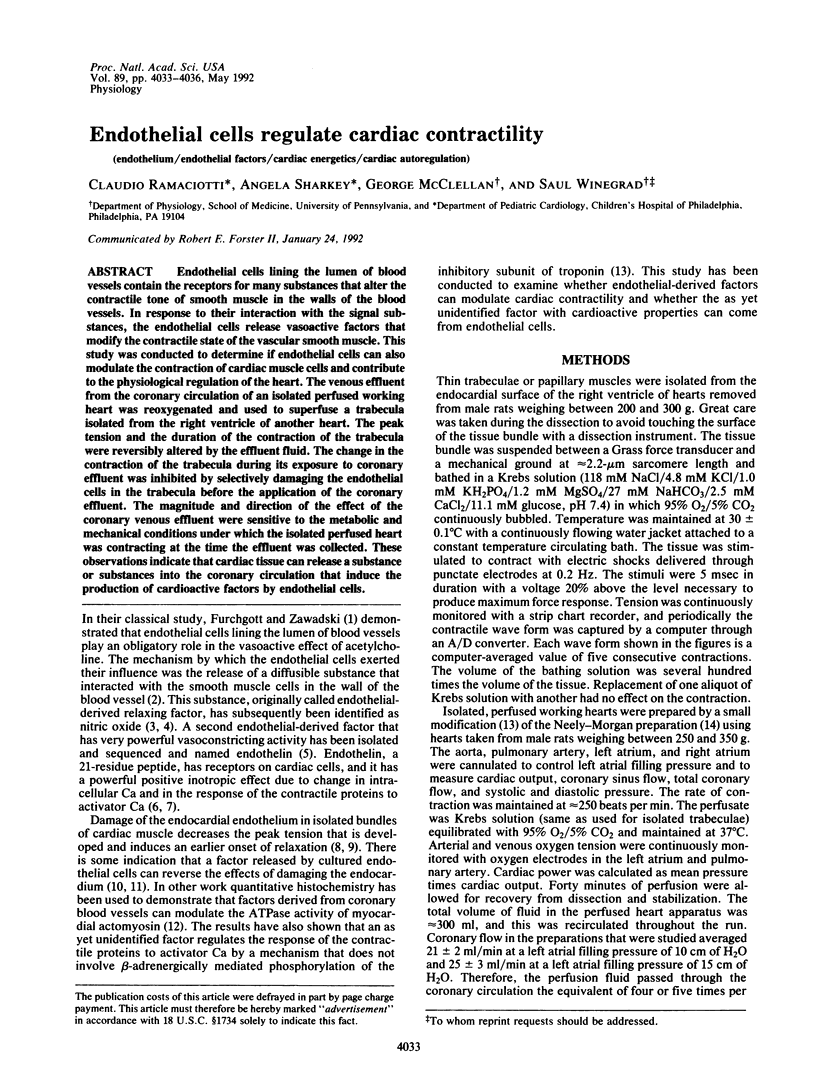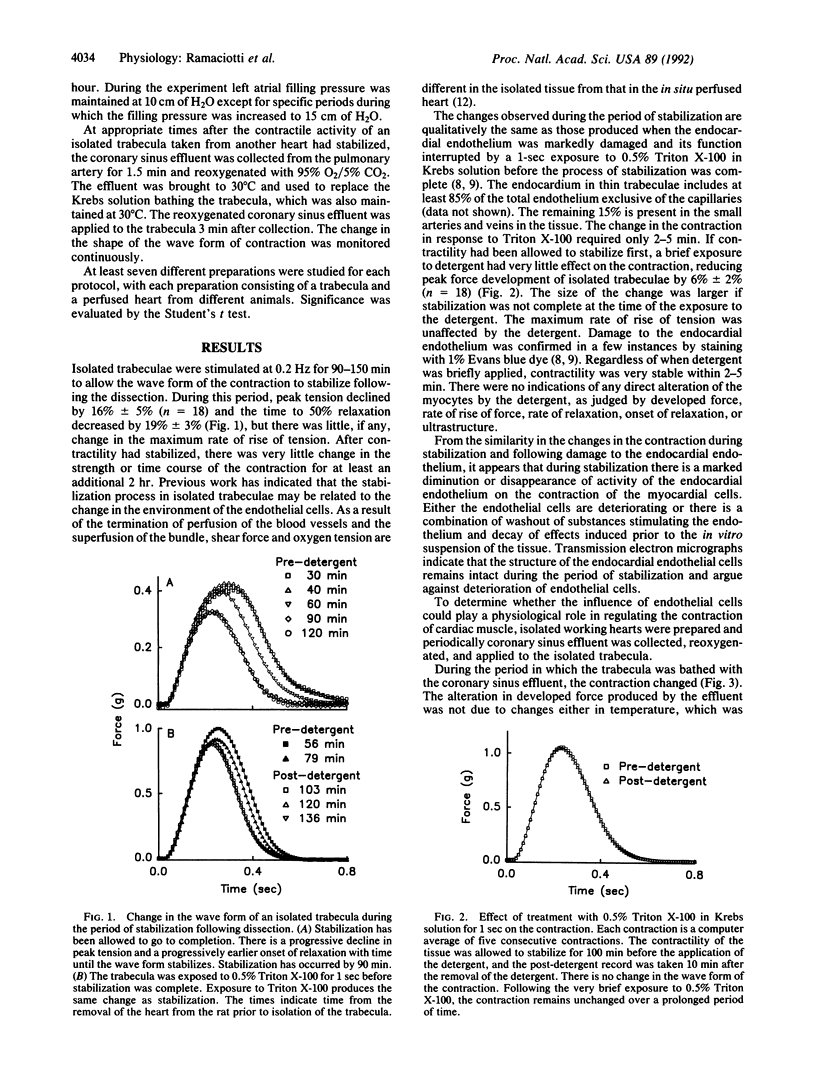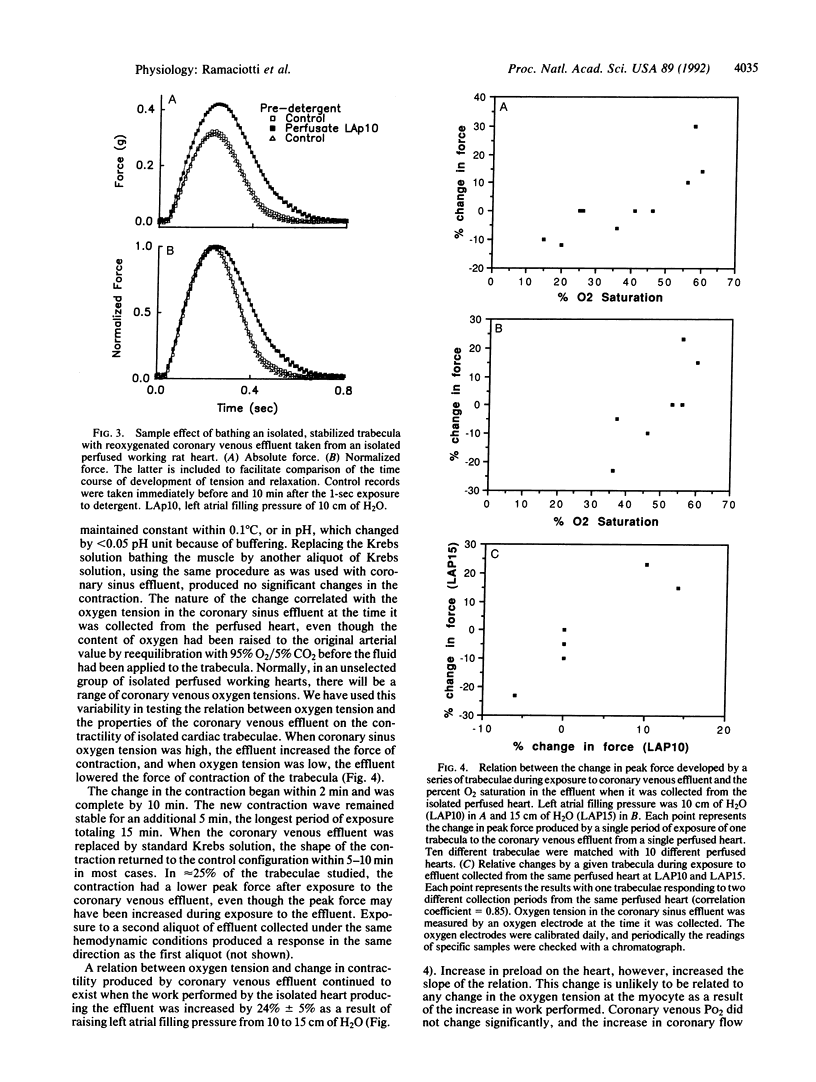Abstract
Endothelial cells lining the lumen of blood vessels contain the receptors for many substances that alter the contractile tone of smooth muscle in the walls of the blood vessels. In response to their interaction with the signal substances, the endothelial cells release vasoactive factors that modify the contractile state of the vascular smooth muscle. This study was conducted to determine if endothelial cells can also modulate the contraction of cardiac muscle cells and contribute to the physiological regulation of the heart. The venous effluent from the coronary circulation of an isolated perfused working heart was reoxygenated and used to superfuse a trabecula isolated from the right ventricle of another heart. The peak tension and the duration of the contraction of the trabecula were reversibly altered by the effluent fluid. The change in the contraction of the trabecula during its exposure to coronary effluent was inhibited by selectively damaging the endothelial cells in the trabecula before the application of the coronary effluent. The magnitude and direction of the effect of the coronary venous effluent were sensitive to the metabolic and mechanical conditions under which the isolated perfused heart was contracting at the time the effluent was collected. These observations indicate that cardiac tissue can release a substance or substances into the coronary circulation that induce the production of cardioactive factors by endothelial cells.
Full text
PDF



Selected References
These references are in PubMed. This may not be the complete list of references from this article.
- Brutsaert D. L., Meulemans A. L., Sipido K. R., Sys S. U. Effects of damaging the endocardial surface on the mechanical performance of isolated cardiac muscle. Circ Res. 1988 Feb;62(2):358–366. doi: 10.1161/01.res.62.2.358. [DOI] [PubMed] [Google Scholar]
- Brutsaert D. L. The endocardium. Annu Rev Physiol. 1989;51:263–273. doi: 10.1146/annurev.ph.51.030189.001403. [DOI] [PubMed] [Google Scholar]
- Furchgott R. F., Vanhoutte P. M. Endothelium-derived relaxing and contracting factors. FASEB J. 1989 Jul;3(9):2007–2018. [PubMed] [Google Scholar]
- Furchgott R. F., Zawadzki J. V. The obligatory role of endothelial cells in the relaxation of arterial smooth muscle by acetylcholine. Nature. 1980 Nov 27;288(5789):373–376. doi: 10.1038/288373a0. [DOI] [PubMed] [Google Scholar]
- Ignarro L. J. Biological actions and properties of endothelium-derived nitric oxide formed and released from artery and vein. Circ Res. 1989 Jul;65(1):1–21. doi: 10.1161/01.res.65.1.1. [DOI] [PubMed] [Google Scholar]
- Ishikawa T., Yanagisawa M., Kimura S., Goto K., Masaki T. Positive inotropic action of novel vasoconstrictor peptide endothelin on guinea pig atria. Am J Physiol. 1988 Oct;255(4 Pt 2):H970–H973. doi: 10.1152/ajpheart.1988.255.4.H970. [DOI] [PubMed] [Google Scholar]
- Kato N. S., Weisberg A., Winegrad S. Effect of left atrial filling pressure on the activity of specific myosin isozymes in rat heart. Circ Res. 1991 Jun;68(6):1582–1590. doi: 10.1161/01.res.68.6.1582. [DOI] [PubMed] [Google Scholar]
- Kelly R. A., Eid H., Krämer B. K., O'Neill M., Liang B. T., Reers M., Smith T. W. Endothelin enhances the contractile responsiveness of adult rat ventricular myocytes to calcium by a pertussis toxin-sensitive pathway. J Clin Invest. 1990 Oct;86(4):1164–1171. doi: 10.1172/JCI114822. [DOI] [PMC free article] [PubMed] [Google Scholar]
- Lin L. E., McClellan G., Weisberg A., Winegrad S. A physiological basis for variation in the contractile properties of isolated rat heart. J Physiol. 1991 Sep;441:73–94. doi: 10.1113/jphysiol.1991.sp018739. [DOI] [PMC free article] [PubMed] [Google Scholar]
- Moncada S., Palmer R. M., Higgs E. A. The discovery of nitric oxide as the endogenous nitrovasodilator. Hypertension. 1988 Oct;12(4):365–372. doi: 10.1161/01.hyp.12.4.365. [DOI] [PubMed] [Google Scholar]
- Neely J. R., Liebermeister H., Battersby E. J., Morgan H. E. Effect of pressure development on oxygen consumption by isolated rat heart. Am J Physiol. 1967 Apr;212(4):804–814. doi: 10.1152/ajplegacy.1967.212.4.804. [DOI] [PubMed] [Google Scholar]
- Nuutinen E. M., Nishiki K., Erecińska M., Wilson D. F. Role of mitochondrial oxidative phosphorylation in regulation of coronary blood flow. Am J Physiol. 1982 Aug;243(2):H159–H169. doi: 10.1152/ajpheart.1982.243.2.H159. [DOI] [PubMed] [Google Scholar]
- Palmer R. M., Ferrige A. G., Moncada S. Nitric oxide release accounts for the biological activity of endothelium-derived relaxing factor. Nature. 1987 Jun 11;327(6122):524–526. doi: 10.1038/327524a0. [DOI] [PubMed] [Google Scholar]
- Smith J. A., Shah A. M., Lewis M. J. Factors released from endocardium of the ferret and pig modulate myocardial contraction. J Physiol. 1991 Aug;439:1–14. doi: 10.1113/jphysiol.1991.sp018653. [DOI] [PMC free article] [PubMed] [Google Scholar]
- Yanagisawa M., Kurihara H., Kimura S., Tomobe Y., Kobayashi M., Mitsui Y., Yazaki Y., Goto K., Masaki T. A novel potent vasoconstrictor peptide produced by vascular endothelial cells. Nature. 1988 Mar 31;332(6163):411–415. doi: 10.1038/332411a0. [DOI] [PubMed] [Google Scholar]


